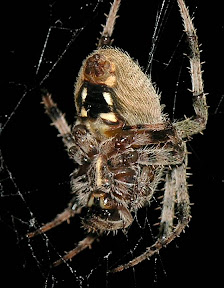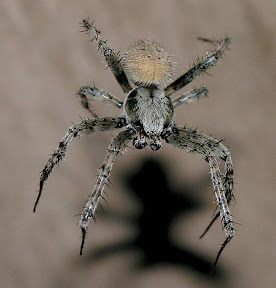
The common name "Barn Spider" is applied to many different species of spiders in the Family Araneidae (Orb Weavers). Getting a species ID on these spiders from a photo ranges from extremely difficult to totally impossible. Species ID often require a detail examination of the female's genitalia which is well beyond my expertise and inclination.
The spider in the photo above is a female. She is almost twice as large as a male of the same species. She is what I sometimes call a "tidy" spider, meaning that she doesn't leave her web up during the day. Instead, this nocturnal spider rebuilds her web every evening. In the morning, she removes the web by eating it and, thereby, reabsorbing the protein that went into its production. She does leave the primary anchor lines for the web in place. During the day, she stays concealed in a location very near where her web is built.

Above is the under side of the same female spider. The red area at the end of her abdomen (Opisthosoma) are her spinnerets where the web emerges.

Above is a male spider of the same species. Notice the two short appendages emerging from under the spider's "face". There are pedipalps, and are used for sensing the spider's immediate environment, for assisting with eating, and for males, reproduction (specifically sperm deposition). Female spiders also have pedipalps, but if the pedipalps resemble boxing gloves (the tips of the pedipalps are swollen), the spider is an adult male.